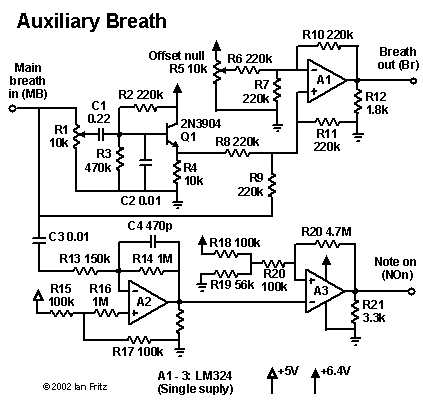Auxiliary Breath Circuit

Here is some circuitry for enhancing the performance of the main breath electronics. The circuit built around Q1 and A1 adds an adjustable amount of the rate of change (derivative, or slope) of the breath signal to the breath signal itself. This provides extra emphasis on the transient part of the breath envelope, thereby adding some "punch" to the resultant sound. The circuitry around A2 and A3 provides a trigger signal when the derivative of the breath signal exceeds a threshold. This allows a new note-on MIDI event to be triggered if a note is tongued before the breath pressure falls below the gate threshold. The result is that double- and flutter- tonguing are much easier to produce than if the basic gate circuit alone is used.
Resistor R1 is a control available to the player that adjusts the amount of slope emphasis. Transistor Q1 and associated components differentiate the breath signal. Note that Q1 is biased to operate near the middle of the power supply voltage, so that both positive- and negative- going derivative signals are generated. Amplifier A1 implements a generalized summer circuit that adds the signals together and compensates for the offset of the derivative signal.
Amplifier A2 is used to make a high-gain differentiator whose output is centered at 2.5 V. The hysteretic comparator build around A3 switches when A2's output changes by about 0.5 V and provides a 5 V logic pulse indicating a note-on event. A similar note-off signal is generated by A4, although this is not shown in the diagram and is not used by the system at this time.
Back Home
